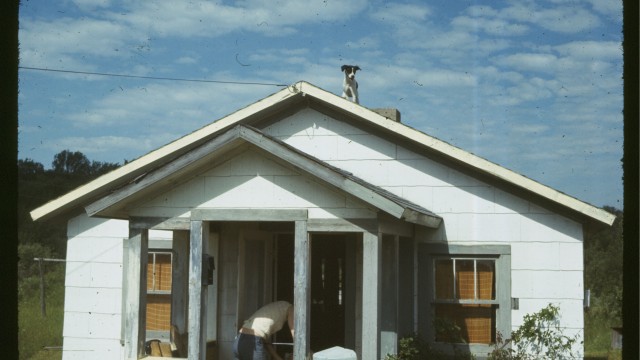
OF TWO COTTAGES: A MEMOIR
I am finishing work on a literary memoir based on my experience growing up in two cottages: one was the “Chicago cottage” originally owned by my Finnish grandparents and the other was the three-room cabin in the woods in Northern Michigan bought by my Dad in the early ‘60s. Both cottages were primitive, but the one in Michigan was particularly so, as it was not equipped with a bathroom or running water. My Mom took my brother and I to live there for a few years when we were very young, and after we returned to live at our Chicago cottage, we still visited our place in the north woods. I have never met anyone else who had a childhood quite like mine. I draw on my memories of the cabin like a reservoir of energy. And since I still live in the Chicago cottage of my grandparents, I am always reminded of those who came before, their experiences gathered in layers like paint and patterned wallpaper. After reading Gaston Bachelard’s Poetics of Space, I began thinking about how so many of my childhood memories are connected to the architectural spaces of these houses: windows, doors, staircases, and the paths connecting them. The following is an excerpt from the unpublished manuscript that relates to the cottage in Michigan. . .
CABIN PATHS
There were a number of paths that we circuited, some well-traveled, some not. After an extended absence, the greatest difficulty lay in finding the driveway. Pulling over off Old Highway 27, we scanned the terrain with baited breath, looking for the dips of the gulley versus the level ground of the entrance. Like magicians incanting the spell to enter, we waited for the grasses to flatten beneath the tires of our car as we sailed into place.
A much-used, yet private path was the one that led from the timbers at the foot of the cabin’s backdoor to the outhouse sheltered beneath the Aspen. Three long planks, butted end to end, jogged along the edge of the avalanching woodpile, back and to the left. Well-shoveled in the winter, it was barely distinguishable in the high grasses of summer. The entrance to the outhouse opened back onto the woods, so you could keep the door propped open. Perching on the toilet-seat, breathing through your mouth, you eyed the Daddy Long-Legs suspiciously as they tremulously staggered through the shadows. Fulfilling its dual function as garden-shed, the outhouse also maintained the lurching handles of lawn-mowers and chain-saws, and disheveled array of dusty tarps. Not a place to linger.
While our cabin faced Old Highway 27 on the East, the relatively new Interstate ran parallel, just a few miles to the West. A dirt road intersected Old 27 a few hundred yards to the North of the cabin, and was forced to dead-end at the new Interstate highway. In between this network of roads were dense woods, swamps and rivers. Since few traveled down dead-end roads, this became our favored path. Just off the side of the dirt road were creeks, clustered with cattails, pussy willows, and the prehistoric horsetail plants. In the late summer, my brother and I liked to venture into these marshy areas, squeezing and splitting the compacted brown tip of the cattail, sending its flecks flying; rubbing our fingertips on the silken grey pods of the pussy willows; and collecting the slim segmented horsetails, snapping them at the joints.
One episode in particular shines: when I was around three years old, we had wandered off the dirt road into the creek. My blue sneakers and socks were soaked. My mother asked me to wait by the side of the road while she and my brother went back to the cabin to retrieve dry shoes and socks for me. While I waited, I gazed past the cattails to the dim shadows of the woods, mesmerized by the sun glinting off the leaves. A white-tailed deer and her speckled fawn stepped gingerly out. After a few quick glances, they ventured to the edge of the creek. They looked at me, and I at them. They must have recognized that I was a child and not a threat. As the deer and I stood gazing at each other, my mother and brother were walking back up the road, witness to this silent theater, wondering when the magic would break and the deer would bound back into the forest.
Perhaps the deer lingered because they could not place my scent. Perhaps children, innocent of the concept of killing, smell differently than adults. Like the scene from Tolkien’s The Hobbit, when Smaug is tensely alert with the visit of Bilbo to his den, having never smelled “hobbit” before. Trolls, elves, and lake-men, yes – but never hobbit.
The fawn craned his neck towards me. I could have touched his velvet nose, but I didn’t. The mother deer spied my Mom approaching from the road, turned with a flip of her white tail and zigzagged into the woods followed by her fawn.